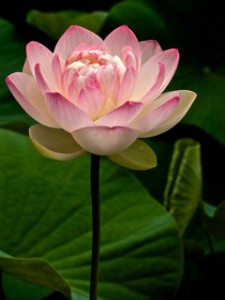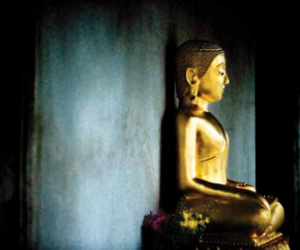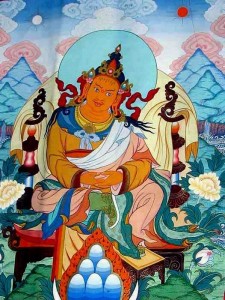Sunday
Dharma TeachingsInvestigation of the Dedication
Taking a closer look at one of our most familiar chants, the Shambhala Dedication of Merit
By Russell Rodgers
By the confidence of the golden sun of the great east,
May the lotus garden of the Rigden’s wisdom bloom.
May the dark ignorance of sentient beings be dispelled,
May all beings enjoy profound brilliant glory.
Sometimes in Shambhala there is a language all of its own. Rather than using foreign words, ordinary language is appropriated for meanings that aren’t necessarily obvious. This could be irritating. On the other hand, words can be teasers that lead to decades of contemplation.
In the title of this chant, we have the words Dedication of Merit. Here, ‘merit’ is related to karma, in the sense that positive or negative thoughts and actions create their own momentum into the future. If these patterns have a positive effect on our path, we might call it “good” karma, or “merit”. Since this is a Shambhala Dedication of Merit we are conscious of the effects of our practice on the society around us. Therefore, when we meditate, we want to dedicate our efforts to enlightening our whole situation, not just ourselves as isolated, self-centered individuals.
 The word “confidence” in the first line is another example of appropriating English words for a very specialized meaning. Confidence refers to a state of mind that is so fundamental and complete that it doesn’t need external supports. Ordinarily, for instance, I might feel confident that I am physically able to climb a mountain. But if my health declined, I wouldn’t feel confident. Because enlightened confidence doesn’t need external supports, there is no fear that supports will be taken away. Therefore it is confident.
The word “confidence” in the first line is another example of appropriating English words for a very specialized meaning. Confidence refers to a state of mind that is so fundamental and complete that it doesn’t need external supports. Ordinarily, for instance, I might feel confident that I am physically able to climb a mountain. But if my health declined, I wouldn’t feel confident. Because enlightened confidence doesn’t need external supports, there is no fear that supports will be taken away. Therefore it is confident.
How can mind be unconditionally confident? Like physical space, mind exists independently of apparent objects that come and go. The mind itself, like space, doesn’t change, but the thoughts and perceptions do. Yogis who realize their minds at this level arrive at a state of confidence. Their minds are like mirrors. Mirrors reflect everything around them, without changing their basic nature as mirrors. Such yogis don’t have to be afraid of anything. In fact, fear is just another temporary reflection in the mirror of their minds.
 In Shambhala, this mirror quality of mind is described as being so vast that it is “cosmic”. If a mirror were that big, you would not be able to see the edges. Without seeing the edges, one wouldn’t recognize it as a mirror. Therefore, one could easily fall into the trap of seeing reflections that arise as solidly existent “things”. In our case, it is hard to see our fundamental mind—we see only thoughts and perceptions, not the empty space of mind that manifests them.
In Shambhala, this mirror quality of mind is described as being so vast that it is “cosmic”. If a mirror were that big, you would not be able to see the edges. Without seeing the edges, one wouldn’t recognize it as a mirror. Therefore, one could easily fall into the trap of seeing reflections that arise as solidly existent “things”. In our case, it is hard to see our fundamental mind—we see only thoughts and perceptions, not the empty space of mind that manifests them.
How might ordinary people like ourselves experience this mirror-like nature? Think of consciousness or awareness– it can illuminate anything, good or bad, without its own nature being affected. Yes, positive and negative thoughts may temporarily obscure it, but the conscious awareness itself remains the same, always there and shining out in the moments between thoughts, like the sun shining through gaps in the clouds.
One might have a sense that our awareness is fragile and easily destroyed by disturbing thoughts. In that case, in order to find confidence, you will need to drop down to the level that the disturbing thoughts originally came from, because that is where confidence resides.
 The “golden sun of the great east” is another example of ordinary language being appropriated for a special meaning. I have a friend, not a meditator, who told me that early morning, as the sun arises in the east, is his favorite time of day. He experiences a sense of peace, perspective and spaciousness before the bustle of his workday begins. I am not a morning person myself– but as a meditator, I can relate to what he is saying, because I understand that there is a sense of spaciousness, peace and perspective when thoughts subside in meditation.
The “golden sun of the great east” is another example of ordinary language being appropriated for a special meaning. I have a friend, not a meditator, who told me that early morning, as the sun arises in the east, is his favorite time of day. He experiences a sense of peace, perspective and spaciousness before the bustle of his workday begins. I am not a morning person myself– but as a meditator, I can relate to what he is saying, because I understand that there is a sense of spaciousness, peace and perspective when thoughts subside in meditation.
My friend doesn’t have the words for it, but I think he is tuning into something profound. Sometimes external circumstances bring one closer to the level of the cosmic mirror. At this level, things seem fresher and more primordial. The “great eastern sun” symbolizes the fact that our minds, while empty like space, also possess radiance. They manifest all the images that we think of as reality, and the awareness itself shines out.
 May the lotus garden of the Rigden’s wisdom bloom. This line starts with the image of a lotus. I have a pond in my front yard with lotuses. Lots of creatures live there, including, for some reason, leeches. My pond doesn’t have any filtration, so when I reach into it, everything I touch has a layer of slippery slime. Sometimes there is so much algae I can’t see the bottom. But when the lotus buds burst out of the water, they are pristine, fresh and extraordinarily vivid– more so than any other flowers in the garden. Traditionally, lotus flowers symbolize the primordial mind that is not contaminated by the mud of samsaric confusion and degradation.
May the lotus garden of the Rigden’s wisdom bloom. This line starts with the image of a lotus. I have a pond in my front yard with lotuses. Lots of creatures live there, including, for some reason, leeches. My pond doesn’t have any filtration, so when I reach into it, everything I touch has a layer of slippery slime. Sometimes there is so much algae I can’t see the bottom. But when the lotus buds burst out of the water, they are pristine, fresh and extraordinarily vivid– more so than any other flowers in the garden. Traditionally, lotus flowers symbolize the primordial mind that is not contaminated by the mud of samsaric confusion and degradation.
Another way of describing the primordial mind is “buddha”, meaning the conscious, awake quality in all of us. In Shambhala, we have a special type of buddha, a “rigden.” If you could look in a mirror and see your essence, you would be seeing a rigden.
Like all buddhas, rigdens symbolize pristine wakefulness. This Rigden, in particular, also symbolizes our connectedness as part of human society. If you doubt this, reflect on the fact that the words that you have been reading here are social in nature. They are the expressions of our common heritage. Even the thoughts that you think are expressed in words that came from and reflect our social being. We may think that we are separate individuals, but we are actually in each other’s minds. We have minds that are innately aware, interested and drawn to each other. This creates, in the Sakyong’s words, an invisible current that runs through our society. Even seemingly negative relationships are an expression of the fact that, at the root, and before interpretations spring up, we are connected. The “Rigden” symbolizes this connectedness at the primordial level of pure, empathetic, awareness.
 We could look at the example of the Tibetan yogi meditating in a cave. Superficially, it may look as though he or she has chosen the ultimate do-it-myself path through life. However, this yogi had teachers, parents and so on. She thinks in Buddhist societal language. Because she is a mahayana practitioner, she knows that the most effective practice is done for the benefit of other sentient beings. Because her friends know that she is doing something that is of the highest benefit for everyone, they bring her supplies so that she can practice. Later, they know that she will likely take students and pass on what she has learned. Supporting her is an investment in the future of society.
We could look at the example of the Tibetan yogi meditating in a cave. Superficially, it may look as though he or she has chosen the ultimate do-it-myself path through life. However, this yogi had teachers, parents and so on. She thinks in Buddhist societal language. Because she is a mahayana practitioner, she knows that the most effective practice is done for the benefit of other sentient beings. Because her friends know that she is doing something that is of the highest benefit for everyone, they bring her supplies so that she can practice. Later, they know that she will likely take students and pass on what she has learned. Supporting her is an investment in the future of society.
The rigden principle takes the mahayana notion of practicing for the benefit of others one step deeper. We practice not just for “others” but for “society”. The rigden principle relates to the goodness at the root of the connections that make up society. In our core, we are not that different from babies, we feed on empathetic connection, harmony, curiosity and kindness. Knowing this, we can see basic goodness possibilities even in negative situations. We can sense that, when the innate social impulses have been blocked, people will feel incomplete and attempt to fill the void externally with consumerism, entertainment, or blaming.
Because the connections we make are seen as basically good, enlightened society arises as a possibility. Even knowing that is a possibility changes how we see things. We no longer see society as something that will always pull us down. This makes forward movement possible.
May the dark ignorance of sentient beings be dispelled,
May all beings enjoy profound brilliant glory.
Trungpa Rinpoche, the writer of these lines, contrasts the striking imagery of the dark ignorance of sentient beings to the state of profound, brilliant glory. In particular, when I lead this chant as an umdze I always wonder how new people will respond to the last three words.
One could only imagine what it would be like to live in a culture where people understood basic goodness and dedicated their lives to realizing it. What would buildings look like? How would they take care of old people? Would they eat animals? What would education be like? What about government? What would the arts express? How would they be in the environment? In the history of cultures and civilizations, we find people expressing goodness in many beautiful ways.
 Russell Rodgers has lived and practiced in the Kootenays since meeting the Vidyadhara in 1975. He is married and has three grown children and one grandchild in different parts of the world. He enjoys dralas of the lakes and mountains where he lives and thinks it’s a great place to practice. Besides the Vidyadhara Trungpa Rinpoche, his view and practice of the dharma have been profoundly influenced by Khenpo Tsultrim Gyamtso Rinpoche, Sakyong Mipham Rinpoche, and Thrangu Rinpoche, and to them he is profoundly grateful.
Russell Rodgers has lived and practiced in the Kootenays since meeting the Vidyadhara in 1975. He is married and has three grown children and one grandchild in different parts of the world. He enjoys dralas of the lakes and mountains where he lives and thinks it’s a great place to practice. Besides the Vidyadhara Trungpa Rinpoche, his view and practice of the dharma have been profoundly influenced by Khenpo Tsultrim Gyamtso Rinpoche, Sakyong Mipham Rinpoche, and Thrangu Rinpoche, and to them he is profoundly grateful.


















Mar 4, 2016
Reply
Thank you Russ and congratulations on becoming a shastri.
As I read your article I feel the depth and devotion that have always been there in your mnanifestation fo the dharma. You have been a fine example a guide to me. I hope to see you again soon.
Much love and gratitude,
Kim
Mar 4, 2016
Reply
Thanks so much! I just shared this with our Shambhala Hoosier Heartland Meditation Group. May it be of benefit! w
Mar 4, 2016
Reply
Beautifully articulated and clear, Russ. Penetrating and yet very accessible. I truly appreciate your written explanations and this is one of the best. Thank you so very much! Very helpful indeed.
Mar 4, 2016
Reply
Thank you Russell. I really appreciated reading your insights. I will share them with the Stockholm, Sweden Shambhala centre.
Feb 29, 2016
Reply
Mr Rodgers- I found this article very helpful. Would you be amenable to letting me ask you a few questions off line? If so, please email me at [email protected]. Thank you.
Feb 29, 2016
Reply
Excellent article. I’ve always thought that chanting the words loses significance in the absence of trying, the best we can, to actually practice the words. In that regard, your final paragraph asks a specific question that I think cuts to the heart of practice. “Would they eat animals?” To me, the answer is obvious. In the 21st century, there is no reason that I can think of that justifies the butchering of an animal. They are sentient beings that feel pain and fear, yes? There are more than enough sources of non-animal protein available to us. To me, eating meat is the elephant in the room (no pun intended!) for anyone that takes the chant seriously. Clearly, we live in a world that doesn’t lend itself to simple black and white, right and wrong, good and bad answers to difficult questions. To me, this particular question is an exception.
Feb 28, 2016
Reply
Thank you so much for your essays on the Shambhala Chants. Your explanations have been of immense benefit to me and our little sangha here in Cuenca, Ecuador.